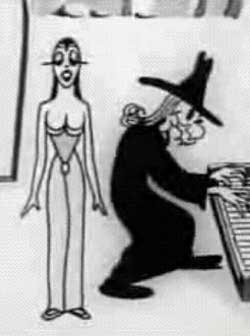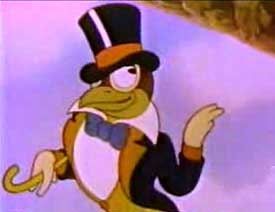 A romantic Color Classic cartoon, Hawaiian Birds (1936) opens with island images & a Hawaiian swing ballad about love in Hawaii. A bird couple flies through the tropical forest twittering, then begin to build a nest.
A romantic Color Classic cartoon, Hawaiian Birds (1936) opens with island images & a Hawaiian swing ballad about love in Hawaii. A bird couple flies through the tropical forest twittering, then begin to build a nest.
Unexpectedly a noisy array of "big city orioles" fly by whistling hot jazz. They land in a nearby tree & do a great ragtime number.
Of the industrious couple, the male keeps building a nest, not noticing his bride is turning flapper & is invited by the bird bandleader to join his troupe. She leaves her huband a dear john note written on a leaf with her beak, & heads off with the band.
Having just finished a wonderful straw hut of a nest, the twittery young bird-groom goes in search of his bride, finding the dear john letter. At first he's sad, but then sets out angrily to find the band.
His quest takes him around the world through wintery climates & horrible hardships. The girl bird has just been kicked out of the Oriole Night Club (inside a big warm street lamp) by the bandleader who is done with her. She now tramps miserably through the snow, remembering her husband & their Hawaiian home.
Deciding to commit suicide by walking off a ledge & dropping into city traffic, she lands instead on top of her husband & they live happily ever after in Hawaii, dumb though that instant ending may be. Not one of the most brilliant Fleischer cartoons, but not terrible either.
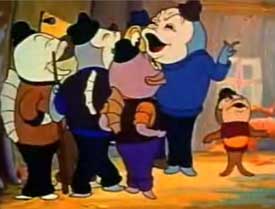 The Hoagy Carmichael/Frank Loesser classic becomes the themesong of one of the best of the later Fleischer cartoons, Small Fry (1939), which opens in the fishes' school room (a sunken barrel) in a pond.
The Hoagy Carmichael/Frank Loesser classic becomes the themesong of one of the best of the later Fleischer cartoons, Small Fry (1939), which opens in the fishes' school room (a sunken barrel) in a pond.
Junior lives in a pumpkin under the sea (absorbant & yellow & porous is he). His mother has a note delivered from the teacher informing him that her son has been playing hooky.
Junior's down at the "Pool Parlor" get-it-get-it, a billiard club under a sunken upturned wooden bucket. He's a complete delinquent with a bowler hat & an attitude, but the big fish bully him. There's a meeting of the Big Fry Club & Junior demands to be a member. The gangsterish big fries tell him "Sure kid, come around about eight o'clock."
As he comes home in his bowler hat, striped t-shirt, & smoking a cigarette, his fretful ma sees him in the distance & sings: "Here comes that good for nothing brat of a boy/ He's such a devil I could whip him with joy/ He's been carousing at the burliecue/ Just watch me teach him with the sole of my shoe."
With this lead in the kid arrives at the door & his mother continues with the main thread of this wonderful song: "Small fry, struttin' in the pool room/ Small fry, should be in the school room/ My my, but down that cigarette/ You ain't a grown up high & mighty yet."
Not listening to his ma's advice he sneaks out of the house that night & the Big Fry Club pretty much terrorize him for sport, sending him blindfolded into the lair of ghostly horrific eels, octopus, killer crab, & glow-in-the-dark fishes from the extreme depths. Lucky to escape with his life he runs home to his weeping ma, having learnt a lesson at last.
I first saw this cartoon on an old black & white set when I was a child. I was afterward singing "You ain't the biggest catfish in the deep blue sea" all over the neighborhood. It's nice to discover as an adult how really good the cartoon is, as it had made such a powerful impact when I was a small fry.
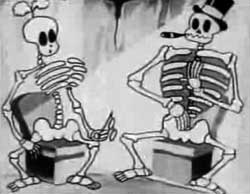 Tom & Jerry were a human duo before the name was used for a cat & mouse series. In the earlier Tom & Jerry cartoon Magic Mummy (1932), it really sounds like Mae Questal doing the voice of the mummy queen, but it's Bonnie Poe, who not coincidentally had done a couple Boops when Questal was unavailable.
Tom & Jerry were a human duo before the name was used for a cat & mouse series. In the earlier Tom & Jerry cartoon Magic Mummy (1932), it really sounds like Mae Questal doing the voice of the mummy queen, but it's Bonnie Poe, who not coincidentally had done a couple Boops when Questal was unavailable.
Van Beuren didn't have the animation chops of the Fleischer Brothers, but his cartoons had wonderful macabre imagination. A long-haired dog-faced skeletal sorcerer has been stealing mummies from the museum & taking them to his underground lair, below a cemetery, where he reanimates the dead.
Tom & Jerry are cops pursuing the thief-sorcerer, following him into his hidden world. The sorcerer puts the double-whammy on our two heros to get them out of the story for a while, then puts a singing-spell on the pretty mummy queen.
He animates an entire audience, chorus, & orchestra of skeletons. The ancient Egyptian princess sings, in the Helen Kane/Betty Boop voice, a perfectly fine ragtime-styled number "Sing, It's Good For You" (not the Luis Prima song of the same title).
Earlier in the cartoon, two obese homosexual cops sing another delightful song, "The Cop on the Beat The Man in the Moon & Me." The guards let the prisoners out for a gay dance. Ah, the pre-Code days!
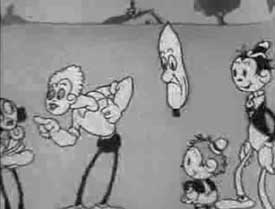 Van Beuren Studio's Tom & Jerry star in Pencil Mania (1932) which begins with the tall & short lads singing "I'm Looking Over a Four Leaf Clover." The music as usual from this studio is by Gene Rodemich.
Van Beuren Studio's Tom & Jerry star in Pencil Mania (1932) which begins with the tall & short lads singing "I'm Looking Over a Four Leaf Clover." The music as usual from this studio is by Gene Rodemich.
Tom is outdoors with his watercolors while a cow dances & Jerry skips along in fairly limited animation void of much backdrop.
Tom spills some paint & jerry sucks it up into a pen. Jerry draws a floating egg which tricks Tom. He then draws a set of dutch wooden clogs which two birds in clogs dance on like a xylophone. Jerry persists in numerous magical performances, including drawing some veggies that spring to life & sing "Yes We Have No Bananas."
The tomato is turned into a lovely lady, the potato into a hunky guy, & they sing a love song, "There's something in your eyes/ That makes realize/ You've got me in the palm of your hand..."
The lovers are pursued by a villain in a set of gags taht take up most of the rest of the cartoon, Jerry appearing now & then with assistance from his magic pencil.
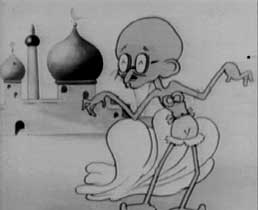 Van Beuren studios made twenty Cubby Bear cartoons in 1933 & 1934. The character was created by Mannie Davis in hopes of competing with the rise in fame of Mickey Mouse. Later some of the same cartoons were recycled as "Brownie Bear" & when television arose in the 1950s, the cartoons were shown randomly under both names.
Van Beuren studios made twenty Cubby Bear cartoons in 1933 & 1934. The character was created by Mannie Davis in hopes of competing with the rise in fame of Mickey Mouse. Later some of the same cartoons were recycled as "Brownie Bear" & when television arose in the 1950s, the cartoons were shown randomly under both names.
Cubby never developed much of a personality. He was just a "fuzzier" version of Mickey with smaller ears who ran his paces through standard gags, with music that was often better than the animation. All the Cubby cartoons, including one that had never been released, are available in one dvd set as The Complete Adventures of Cubby Bear (2006).
Croon Crazy (1933) is a so-so cartoon casting Cubby as a radio host on the radio brought to you by the MacHangnail Cutical Company. Although Cubby looks like a child, he has a deep crooner's voice, singing his theme song on the radio waves.
Cubby had arranged a large roster of guests, but as luck would have it they all send telegrams with various excuses. So Cubby relying on his powers as a mimic does a one-man-band performance pretending to be Sol Wrightman & his orchestra, wearing a Sol Wrightman mask as though anyone could see him on the radio.
He gets in blackface to imitate Al Jolson singing to his Mammy. In full drag he imitates Mae West. He croons as Paul Whiteman.
We follow some radio waves to India where some harem babes are dancing for a sweaty sultan, then we see a bulby-headed caricature of Gandhi dancing in front of the Taj Mahal. The action shifts to Holland where wooden shoes dance in front of windmills & tulips ring like bells.
Next we're in Spain with a toreodor who stops fighting the bull so they can dance to the music. At the North Pole eskimo maidens dance before an igloo, morphing into South Seas babes dancing in front of palms. Off to Bohemia we go where girls are whirling like mechanical ballerinas. Back in America, Indian maidens are rain-dancing.
There follows a set of nature shots of ducks, bees, & so forth, singing along, though they don't have radios. The cartoon ends with everything in the radio studio crashing.
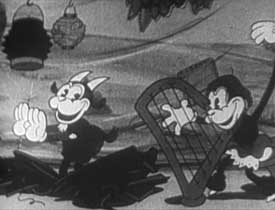 Goofy Goat Antics (1933) came out of the tiny production studio of Ted Eshbaugh in California, originally in two-strip technicolor, but no color copy has survived.
Goofy Goat Antics (1933) came out of the tiny production studio of Ted Eshbaugh in California, originally in two-strip technicolor, but no color copy has survived.
Eshbaugh's studio was one of many that came & went in this era, as competition was heavy, & it could be argued that characters like Goofy Goat just weren't that wondrous.
Goofy drives along the road singing happily, rips off his own horns to play them as a musical instrument. An enormous pig is riding in the back of a limousine & Goofy tailgaits in his minsicule vehicle, shouting, "Get out of the way you road hog!"
After the motoring gags have run their course, Goofy struggles out of the tiny car, puts it in his pocket, & is welcomed into the Glee Club where a party is going on. Animals are putting on a show, like three little kittens singing "Three Little Kittens." The acts are fast & numerous, the zoo & barnyard audience rowdy.
An accordian act by Goofy results in the accordian trying to escape like a worm. Goofy plays a snake-charming tune on a whistle, then he & the worm-accordian dance, box, spank, bite, until the worm-accordian is eaten by a pelican, upon which Goofy & his gal-pal ride away.
Continue to fourth batch of
Musical Cartoons
copyright © by Paghat the Ratgirl
|
